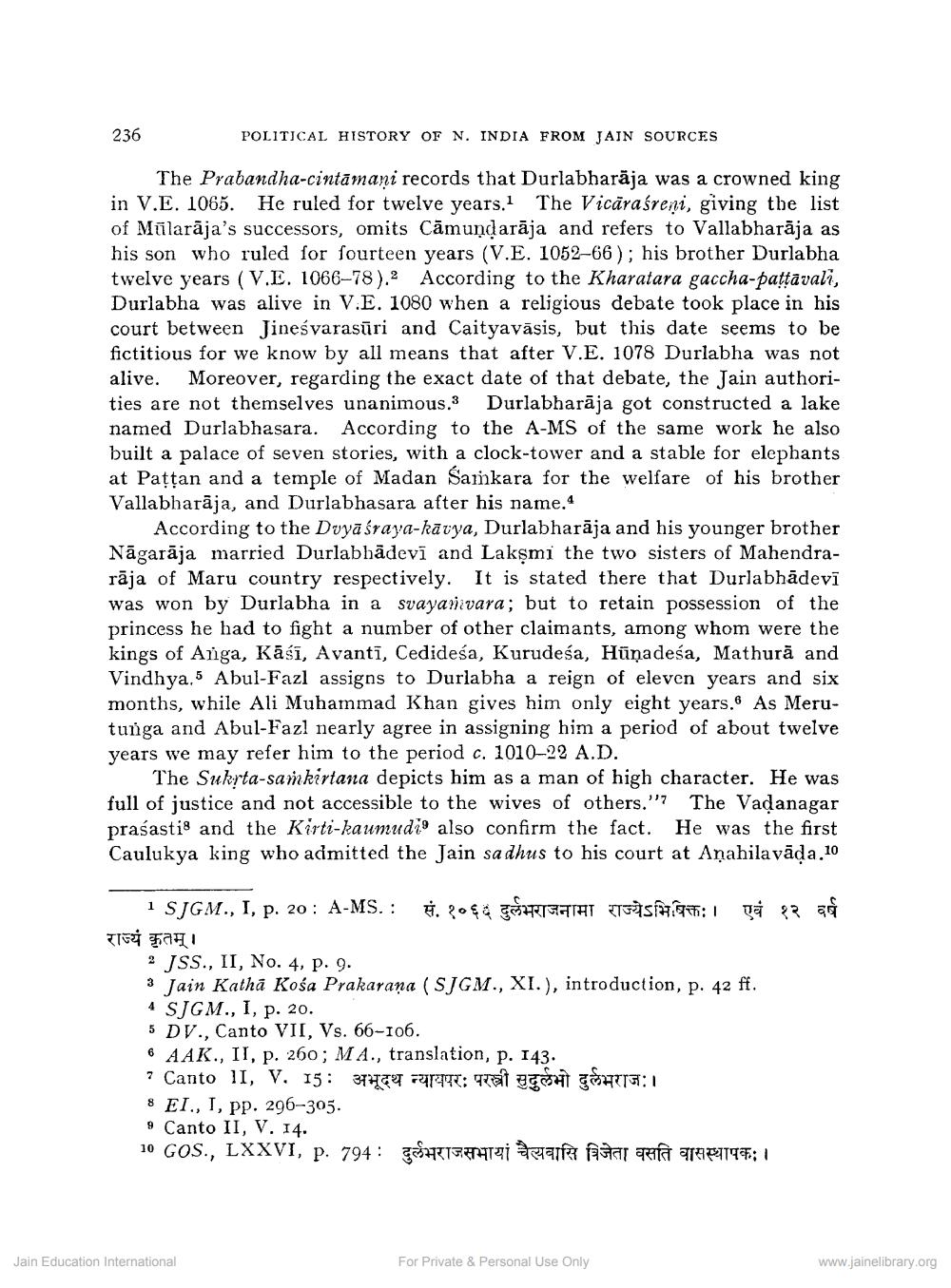________________
236
POLITICAL HISTORY OF N. INDIA FROM JAIN SOURCES
The Prabandha-cintāmaņi records that Durlabharăja was a crowned king in V.E. 1065. He ruled for twelve years. The Vicāraśreni, giving the list of Mülarāja's successors, omits Cāmundarāja and refers to Vallabharāja as his son who ruled for fourteen years (V.E. 1052–66); his brother Durlabha twelve years (V.E. 1066-78). According to the Kharatara gaccha-pattavali, Durlabha was alive in V.E. 1080 when a religious debate took place in his court between Jineśvarasūri and Caityavāsis, but this date seems to be fictitious for we know by all means that after V.E. 1078 Durlabha was not alive. Moreover, regarding the exact date of that debate, the Jain authorities are not themselves unanimous.3 Durlabharāja got constructed a lake named Durlabhasara. According to the A-MS of the same work he also built a palace of seven stories, with a clock-tower and a stable for elephants at Pattan and a temple of Madan Samkara for the welfare of his brother Vallabharāja, and Durlabhasara after his name.
According to the Dvya śraya-karya, Durlabharāja and his younger brother Nāgarāja married Durlabhādevī and Lakşmi the two sisters of Mahendrarāja of Maru country respectively. It is stated there that Durlabhādevī was won by Durlabha in a svayarivara; but to retain possession of the princess he had to fight a number of other claimants, among whom were the kings of Anga, Kāśi, Avantī, Cedidesa, Kurudesa, Hüņadeśa, Mathurā and Vindhya 5 Abul-Fazl assigns to Durlabha a reign of eleven years and six months, while Ali Muhammad Khan gives him only eight years. As Merutunga and Abul-Fazl nearly agree in assigning him a period of about twelve years we may refer him to the period c. 1010-22 A.D.
The Sukrta-sankirtana depicts him as a man of high character. He was full of justice and not accessible to the wives of others."'? The Vadanagar prasastie and the Kirti-kaumudi' also confirm the fact. He was the first Caulukya king who admitted the Jain sadhus to his court at Aşahilavāda. 10
2 ad
1 SJGM., I, p. 20 : A-MS. : .2048 FATAT TESIHAT: 1 a राज्यं कृतम्।
2 JSS., II, No. 4, p. 9. 3 Jain Kathā Kośa Prakarana (SJGM., XI.), introduction, p. 42 ff. 4 SJGM., I, p. 20. 5 DV., Canto VII, Vs. 66-106. 6 AAK., II, p. 260; MA., translation, p. 143. ? Canto II, V, 15: 37H52T FERTTT: wat as SHs: 1 8 EI, I, pp. 296-305. 9 Canto II, V. 14. 10 GOS., LXXVI, p. 794 : HTTF#42 STAIR ESTETT 94194; 1
Jain Education International
For Private & Personal Use Only
www.jainelibrary.org




